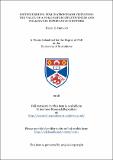Files in this item
Distinguishing pollination from visitation : the value of a pollinator effectiveness and pollinator importance network
Item metadata
| dc.contributor.advisor | Willmer, Pat | |
| dc.contributor.author | Cunnold, Helen Elizabeth | |
| dc.coverage.spatial | xiii, 289 p. | en_US |
| dc.date.accessioned | 2018-10-01T13:56:55Z | |
| dc.date.available | 2018-10-01T13:56:55Z | |
| dc.date.issued | 2018-06-27 | |
| dc.identifier.uri | https://hdl.handle.net/10023/16121 | |
| dc.description.abstract | For over twenty years, flower-visitation networks have been used to assess the effects of pollinator decline, linked to habitat loss, climate change and invasive species, on entire communities. However, most rely on flower visit frequency as a proxy for pollination; very few sample pollen from flower visitor’s bodies or from stigmas and so do not include a quantitative measure of pollination success. Here, I add pollinator effectiveness (as single visit pollen deposition) into a traditional flower visitation network, creating a pollinator importance network that better evaluates the flower visitor community from the plant’s perspective. Given recent interest in pollination in urban areas, I use an urban garden habitat, and compare visitation, pollen transport and pollinator importance networks, giving several novel conclusions. Firstly, although there are similarities in the structure of my networks, interactions were most specialised in the pollinator importance network, with pollen transport proving to be a better proxy for pollinator importance than visitation alone. Secondly, the specialisation of individual plants and the role of individual flower visitors varied between the networks, suggesting that community-level patterns in simple visitation networks can mask important individual differences. Thirdly, the correlation between flower visit frequency and pollinator importance largely depends on bees, and may not hold in plant-pollinator communities that are not bee-dominated. Fourthly, heterospecific pollen deposition was relatively low, despite the unusually diverse plant community of a garden. Finally, bees (particularly Bombus and non-eusocial halictids) carried the largest pollen loads and were the most effective at depositing pollen on to the stigma during a single visit in this garden habitat. The implications of this thesis highlight the strengths and limitations of each network for future studies, and raise important questions for the future of urban pollination studies. | en_US |
| dc.language.iso | en | en_US |
| dc.publisher | University of St Andrews | |
| dc.subject.lcc | QK926.C8 | |
| dc.subject.lcsh | Pollination by insects | en |
| dc.subject.lcsh | Pollination by bees | en |
| dc.subject.lcsh | Insect-plant relationships | en |
| dc.title | Distinguishing pollination from visitation : the value of a pollinator effectiveness and pollinator importance network | en_US |
| dc.type | Thesis | en_US |
| dc.contributor.sponsor | University of St Andrews. School of Biology | en_US |
| dc.contributor.sponsor | Russell Trust | en_US |
| dc.type.qualificationlevel | Doctoral | en_US |
| dc.type.qualificationname | PhD Doctor of Philosophy | en_US |
| dc.publisher.institution | The University of St Andrews | en_US |
This item appears in the following Collection(s)
Items in the St Andrews Research Repository are protected by copyright, with all rights reserved, unless otherwise indicated.

